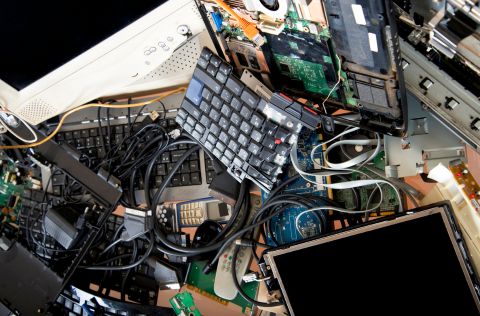E-waste

E-waste (electronic waste) is the fastest-growing category of waste worldwide. E-waste refers to unwanted and discarded electrical and electronic products – essentially anything powered by batteries or an electrical cord and plug. It is estimated that one in five Australians have a stash of e-waste in their home or office.
According to Sustainability Victoria, many Victorians are unsure of what e-waste is and how to dispose of it. Many either donate unwanted and even broken items to charity shops, or store in garages and sheds until they decide what to do. Unfortunately, some e-waste gets dumped at clothing recycling bins situated at train stations and shopping centres or even dumped on the sides of roads. Sadly, the vast majority of smaller items are included in general rubbish bins each month and end up in landfill.
E-waste doesn't belong in landfill. The Victorian Government banned all e-waste from landfill from 1 July 2019, urging Victorians to do the right thing and embrace responsible e-waste disposal.
What are some examples of e-waste?
E-waste includes:
- larger household ‘white goods’ such as washing machines, dishwashers, fridges, freezers, ovens and microwaves
- home entertainment products such as televisions, CD players, DVD players, tablets, mobile phones and other handheld electronic devices
- electrical gardening equipment such as hedge trimmers, leaf blowers, electric chainsaws, whipper snippers and electric lawn mowers
- smaller household items such as toasters, kettles, irons, lamps, battery operated or electronic toys, hairdryers, fans, heaters, and printers
If in doubt it is always best to remember if it has a cord, plug or battery it is e-waste.
Why should I recycle e-waste?
There are many reasons why you should recycle e-waste, including
- It's good for the environment - all e-waste products can contain hazardous materials. Ranging from heavy metals like lead, mercury and cadmium to ozone-depleting chlorofluorocarbons (CFCS) and flame retardants. Even in small amounts, these dangerous chemicals can cause environmental contamination. When you multiply it by the millions of e-waste items being left in landfills, the situation becomes much more serious.
- It's good to recover and reuse - e-waste also contains a whole range of valuable materials, including tin, nickel, zinc, aluminium, copper, silver, gold and plastic. A million mobile phones contain an estimated 15–16 tonnes of copper, 340–350 kilograms of silver and 24–34 kilograms of gold. When you consider there are more than 22 million discarded mobile handsets in Australia and growing, we’re throwing away a lot of precious resources.
- Keep it out of landfill - In 2016, 44.7 million metric tonnes of e-waste was generated worldwide, but only about 20 per cent, or 8.9 million metric tonnes of this was recycled. The rest ended up in landfill. When you think about all the other rubbish that goes to landfill, keeping e-waste out is a much smarter idea.
Where can I recycle e-waste?
Council encourages residents to manage their e-waste by dropping it at our Resource Recovery Centres (RRCs) in Alexandra, Kinglake and Yea. Alternatively, you can use one of the other e-waste drop off/collection services listed on Sustainability Victoria's website.
Recycling of computers and televisions is free of charge at our participating RRCs as it is subsidised by the ‘National Television and Computer Recycling Scheme’. There will be a small fee of $2 per item for the disposal of other e-waste.
What happens to the e-waste collected?
Have you ever wondered... does it really get recycled? E-waste that has been collected and stored at Council's participating Resource Recovery Centres is periodically collected by our e-waste recycling contractor. It is then taken to the contractor's EPA-certified facility to be sorted into the different recycling streams.
Click on the video links below to learn what happens to your e-waste when it's correctly disposed of.
The story of a broken kettle
The story of a broken printer
The story of a broken drill
How can I avoid creating e-waste in the first place?
Recycling your e-waste is important and necessary. But even better is to try and avoid creating e-waste in the first place. You can do this by:
- carefully selecting the right product for your needs
- choosing a brand that's environmentally responsible
- only upgrading your technology if there's a real reason to do so
- supporting businesses that are working to solve the e-waste problem
If you have an item you no longer need, but which still works and is in good condition, consider trying to find a new home for it first. There are many people happy to take quality second-hand goods. You could:
- offer it to friends or family
- try swapping or giving it away for free via an online recycling site
- donate it to a charity or not-for-profit organisation
- sell it - there’s a large market for quality second-hand electronics and you’ll make money and be helping reduce the e-waste burden